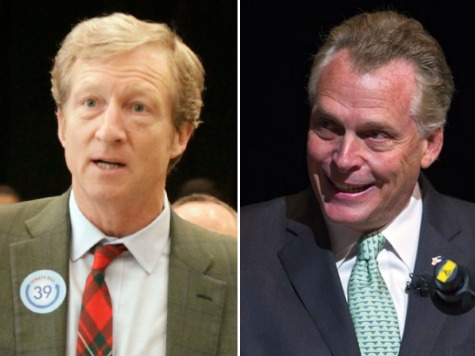
Virginia gubernatorial candidate Terry McAuliffe said in 2009 he “never want[s] another coal plant built,” but in the meantime, he hasn’t been above taking money gained through coal investment for his campaign.
Tom Steyer, a California-based financier and one of McAuliffe’s wealthiest out-of-state supporters, told his advisers in August to launch climate change television ads via his group, NextGen Climate Action Committee, in Virginia to help turn out the vote for McAuliffe, Politico reported in August.
Steyer (pictured, left) said, “I would say there’s a very clear choice on this topic between these two candidates, and I think the citizens of Virginia deserve to understand both what the truth is and what the implications of that are.” The billionaire hedge fund executive who founded Farallon Capital Management in 1986 and left the company 2012 thinks of himself as an environmentalist. His track record, however, shows a different story.
In 2008, Farallon heavily invested in Adaro, Indonesia’s second-largest coal company. Indonesia is the world’s largest exporter of thermal coal and, according to Reuters, China is Adaro’s biggest customer. In 2010, Calwatchdog points out, Steyer also did not support California’s proposition 23. Rejected by California voters in November of 2010, prop 23 asked for the repeal of a law, signed by Governor Shwarzenegger in 2006, which aimed at rolling back California’s greenhouse gas emissions to 1990 levels by 2020.
NO on 23 backer and Democrat Tom Steyer’s Farallon Capital Management Company holds stock in “dirty coal,” nuclear, and oil and gas companies, and in a Chinese solar panel supply company that potentially would rob jobs from Californians, even as the NO on 23 campaign blasts Prop. 23 backers for similar investments.
So-called powerhouse Democratic donor Tom Steyer, who has donated $5 million to defeat Prop 23, which would suspend green power in California, runs an investment firm that holds stock in “dirty coal” and nuclear plants, oil and gas companies in Texas, Oklahoma and Louisiana. Additionally, Steyer’s investment firm holds stock in the leading photovoltaic solar panel supplier in California, Yingli Green Energy Holding Company of China.
Steyer’s firm, Farallon Capital Management Company, also is an external fund manager for CalPERS.
San Diego Reader did not buy Steyer’s clean energy campaign, either:
The supposed green billionaire hedge-fund manager philanthropist Tom Steyer is at it again trying to buy an election for his personal profit. Steyer backed a “No on 23” campaign in 2010 along with an executive of Haliburton that would have suspended California’s Cap and Trade (which has nothing to do with the environment and everything to do with gaming the market when you examine it) and hurt his energy investments that would be subsidized by California Cap and Trade.
Steyer is presently a lobbyist who is making money off of opposing the Keytone XL pipeline. He committed $1 million of his own money for a campaign to block TransCanada Corp’s project, according to Canada’s Globe and Mail.
Steyer’s hedge fund also invested in two oil and natural gas companies: Sandridge Energy and Energy Partners, Ltd. However, Steyer’s accumulated wealth from his oil, gas, and coal investments during his time at Farallon has not stopped him from campaigning around Virginia for McAuliffe as a green energy promoter:
“Our experience has been that having a business voice talking about jobs is an essential part of talking about any economic change,” Steyer said. “If you get away from that, then you get away from what the human beings in this society care about.”
The Virginia coal sector, he said, gets “amazing deference for a whole bunch of reasons, including the fact that there’s very high unemployment there, that there’s not a second job if those jobs go away, the … toughness of that job and how painful it’s been for everybody involved.
“But there’s no sense of, what are the alternatives? How many jobs are we giving up by doing that? If we start going in a different direction, how much growth are we going to engender?”

COMMENTS
Please let us know if you're having issues with commenting.